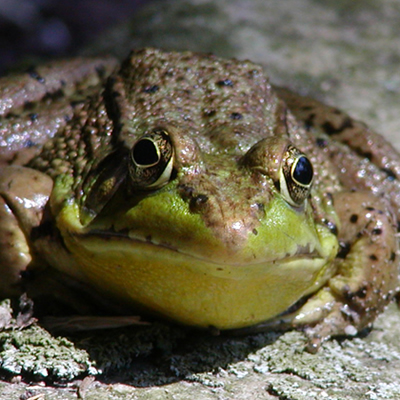In some regions it is however advisable to house your fish indoors during the roughest months since it can suffocate in a pond if the ice freezes across the entire surface.
Goldfish can be kept in ponds as well as in above ground pools. It is recommended to add plants to your pond/pool since goldfish will feel much safer in a natural environment.
With plants in your pond, your fish will also be able to hide among the them in order to avoid predators. A lot of animals like to chase and eat goldfish, including cats, birds, and raccoons.


Sometimes plants are not enough to guard your fish and you will be forced to cover the pond with netting during the night. In an above ground pool with straight sides, the predators will be unable to wade in and must instead perch themselves at the edge of the pool when looking for prey.
This will usually be noticed
by your goldfish and it can seek shelter deep down
in the pool.
A planted goldfish pond is easier to maintain since
the plants will aid you in keeping up the water quality.
Live plants can use organic compounds excreted by fish as nutrition. This means that the organic waste will be absorbed by the plant instead of staying in the water and polluting it.
Live plants will also inhibit algae growth since plants and algae compete for the same nutrients. If you still experience excess algae growth, you might be feeding your fish too much.
If you feed your fish a lot of food, they will subsequently produce a lot of waste and there will be plenty of nutrients for plants as well as algae in the water.
Some algae are a natural part of any pond or aquarium, but excessive algae growth should be counteracted since it is unhealthy for the fish.
Keep in mind that if you use a chemical to kill the algae, or if an algaecide is involuntary introduced to the pond, the dead and decaying algae will use up a lot of oxygen and your goldfish might suffocate and die. Using natural methods to combat algae, such as plants, is therefore recommended.

When you have filled your goldfish pond you should
treat the water with a water conditioner if you use
tap water containing chlorine and/or ammonia to fill
your pond. Check that the water temperature in the
pond is at least 60° F before you add any fish.
A common beginner mistake is to add all the goldfish simultaneously to their new home. Thisis a mistake, because it will cause a rapid change in water quality since the bacterial colonies that inhabit the pond are too small to process the sudden increase in organic waste.
Instead, you should ideally add one or two fish and allow the bacterial colonies to grow larger before you add any new fish. This will naturally also depend on the size of your pond and if you are using any type of filtration.
In a large pond, excess waste will be dilute by a very large amount of water and therefore less likely to reach concentrations high enough to harm you fish. Good filtration will also help removing organic waste and other toxins from the water.
How Many Goldfish Can Live in My Pond?
As a rule of thumb, one goldfish per 30 gallons is recommended, but this is naturally a very imprecise ratio. As mentioned earlier, the water quality is one of the limiting factors.
Plenty of water, developed bacterial colonies and good filtration will make it possible for you to house a larger number of goldfish.
Pond Filtration
There are three basic types of filtration: biological, mechanical and chemical. Biological filtration will be taken care of by the mentioned bacterial colonies.
A mechanical filter will filter the water through some form of filtering media where larger debris will get caught.
Chemical Filtration for Fish Ponds
The most common form of chemical filtration is the addition of carbon to the mechanical filter, where the carbon will bind various types of toxins. Another important factor to keep in mind when you decide how much fish you wish to add to your pond is aeration.
Fish require air to breath and will suffocate in a poorly aerated pond, especially if decaying plant matter consumes a lot of the dissolved oxygen.
In an open pond, there will however be a considerable gas exchange between the water and the surrounding air. The larger the surface area of your pond, the more oxygen will be brought to the water.
A large surface area will also make it easier for the water to release carbon dioxide. Plants in the pond will also produce oxygen and consume carbon dioxide. In some ponds, this will however not be enough and if you want to be able to house a large number of Goldfish some type of aeration is recommended.
About the Author: By William Berg
Read more about garden ponds on http://www.aquaticcommunity.com/universal-id51.html and how to maintain your new goldfish pond on http://www.aquaticcommunity.com/universal-viewid365.html
Source: www.isnare.com
Grow Your Own Food, Herbs, and Flowers With Less Work

Related Pages
Home :-: Shop :-: Coloring :-: Clip Art :-: Printables
Search :-: Privacy :-: Site Index



